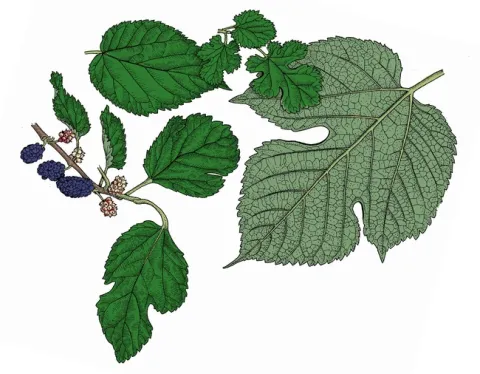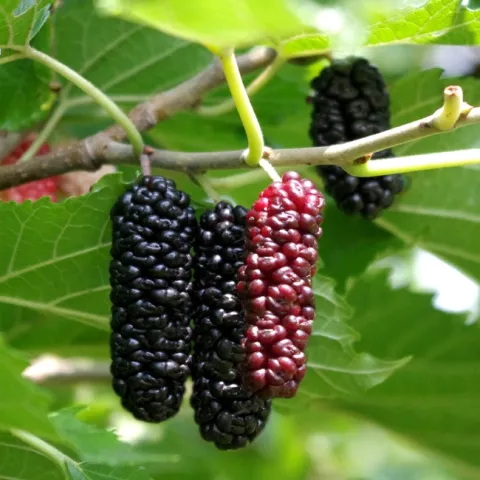The Very Berry, Mulberry Morus species

One way to id the different species is by looking at the leaves. They have alternate leaves. If the leaf is short and the base is heart-shaped then it's probably a Black Mulberry. If the leaf has rounded teeth along the edge, then it probably a Red or White Mulberry. The leaves of the White Mulberry are glossier than the Red Mulberry. I feed the leaves to my Tortoises. The leaves are rich in carotene, calcium, and fiber.
Mulberry trees are deciduous, fast-growing trees. They grow approx. 10 feet the first year, with little to no fruit, they then slow their growth. Mulberries eventually grow to 30-60 feet tall.
The wood is very flexible and durable. It has been used to make tennis rackets, hockey sticks, boats, fence posts, barrels, and furniture.
Some mulberry trees are monoecious (they have male and female reproductive systems). Others are will set fruit without pollination. Which means you do not need two trees in order to produce fruit.
White Mulberry. Morus alba
The leaves are glossy, large with deep lobes. Frequently they have three lobes and look like a Fleur-De-Lys. But they can also can oval with toothed edges. They are straight where the leaves meet the stem. The fruit is very sweet if picked at the correct time. If you pick them too soon. Whoa, look out! It's tart! The fruit starts at the green, then white, then turns pink, and in some varieties finally turns reddish-purple.
The leaves of the white mulberry tree are grown to feed silkworms. It's cheap food for them. The ‘Silk Road” from Turkey to China brought many products of silk into the trade industry. China and India are the two main producers of silk today. In 1733, General Oglethorpe imported 500 white mulberry trees and tried to start the silkworm industry. But everyone ended up using the trees for fruit and to feed their livestock.
Black Mulberry. Morus nigra
Heart-shaped leaves with toothed edges. The fruit looks like a large blackberry or a loganberry. The fruit starts at the green, then turns pink, then finally to a beautiful dark purple.
The mature fruit contains significant amounts of resveratrol. Resveratrol is thought to act like antioxidants, protecting the body against damage that can put you at higher risk for things like cancer and heart disease. It's in the skin of red grapes, but you can also find it in peanuts and berries. Unripe fruit and green parts of the plant have a white sap that is intoxicating and mildly hallucinogenic.
Mulberry fruit does stain. Anthocyanins from the mulberry fruit. Anthocyanins are edible, water-soluble vacuolar pigments that belong to a class of molecules called flavonoids and that may appear red, purple, orange, blue or black, according to pH. Anthocyanins hold potential use for health benefits (Gross 2007) and as natural food colorants. As the safety of synthetic pigments is doubted and in the wake of increasing demand for natural food colorants, their significance in the food industry is increasing. In addition to yielding attractive colors, they are water-soluble and thus are easily incorporated into aqueous food systems.
Anthocyanins also possess an antioxidant property and are being investigated for antineoplastic, radiation-protective, vasotonic, vasoprotective, anti-inflammatory, chemopreventive, and hepato-protective properties.
There are some chemicals in the white mulberry that works similar to medicines used to treat type 2 diabetes. They slow the breakdown of sugars in the gut so they are absorbed slower into the blood. This is not medical advice. Talk to your doctor first!!!
The fruit is actually a Drupe. A tiny cluster of tiny fruits, each with a seed. It used to make tarts, pies, wine, jams, jellies, sherbets, and cordials. And maybe a margarita or two.


